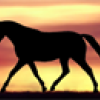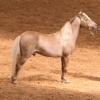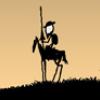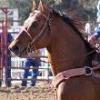Bider Markings
Forums
Re: Bider Markings
I found more pictures on this website of a Bashkir stallion with a big Bider mark and there are some of his foals with it, too!
http://www.fjarens.nu/ (Hingstarna and Folen-07) The stallion's name is Yuri.
Has any ever seen this in other breeds? I'm curious now.
Re: Bider Markings
[quote="Third Peppermint"]I found more pictures on this website of a Bashkir stallion with a big Bider mark and there are some of his foals with it, too!
http://www.fjarens.nu/" onclick="window.open(this.href);return false; (Hingstarna and Folen-07) The stallion's name is Yuri.
Has any ever seen this in other breeds? I'm curious now.[/quote]
I think the only other photo I've seen on the net is of that same stallion, standing next to a red barn if I recall?
So are these markings like the mottling seen on the shoulder and neck of some duns? Sorry if the article answers that, haven't red it yet. I'll try to find that photo, it's come up a number of times in other discussions.
Re: Bider Markings
the homozygous horse sight has it listed, http://www.homozygous-horses.com/weird…" onclick="window.open(this.href);return false;
On the home website, I think there may be some others, but the images are two small to tell. This is the best one, a head shot of Yuri http://web.comhem.se/~u86419291/Yuri.JPG" onclick="window.open(this.href);return false;
Re: Bider Markings
Yeah, I saw those ones! They're hard to find. The article said it was skin pigment, like a tattoo, and was the same on both sides. Pretty strange. They also said it was only found in Mongolian and Przewalski's, but I saw it in the Bashkir. However, the Bashkir (like Yuri and the other one I think) have a territory that overlapped with the other horse breed(s) AND there seems to be plenty of opportunity for people to have brought in Mongolian or Przewalski stallions.
The weird thing is that QH/draft cross... The article seemed convinced the genetics behind that marking comes from Przewalski's since they have the highest incidence of it and the Mongolians with it had Przewalski influence. How would a QH/draft cross get it? Could it have remained hidden for that long in the bloodlines or do people just not notice the smaller Bider markings?
Re: Bider Markings
Hi! New member!
I was referred to this thread by a member here. Not sure her name on THIS board though ymwhisle lol we're on a few.
Anyway, I breed duns specifically for dun factor, especially "mottling" which is the dun term equal to these "bider markings"
A lot of our horses even have mottling, with or without their "barring", on their legs.
I thought I'd share some.
I DO have one mare who's neck is covered on both sides. But waiting to get them scanned onto a computer. They're prints of her.
MOTTLED BARRING (on 3 month old)
[img]http://sphotos.ak.fbcdn.net/hphotos-ak-…]
[img]http://sphotos.ak.fbcdn.net/hphotos-ak-…]
THIS IS MORE CONVENTIONAL BARRING WITH MOTTLING (on a 3 year old)
[img]http://sphotos.ak.fbcdn.net/hphotos-ak-…]
[img]http://sphotos.ak.fbcdn.net/hphotos-ak-…]
HER LEGS AS A 2 YEAR OLD (to see the color begin to mass)
[img]http://c1.ac-images.myspacecdn.com/imag…]
THE SAME 3 YEAR OLDS NECK AND SHOULDERS
not the best shots... but you get the idea:
[img]http://www.baywindfarm.com/forum/pictur…]
[img]http://c3.ac-images.myspacecdn.com/imag…]
[img]http://c4.ac-images.myspacecdn.com/imag…]
:ymdaydream: Enjoy!
Re: Bider Markings
OH.. and since you're talking Przewalski...
I honestly believe that is really why duns exist in the first place...
The three year old I posted above?
This is her at 2 weeks old...
And all horses I have a registered AQHA and foundation lines.
[img]http://sphotos.ak.fbcdn.net/hphotos-ak-…]
See anything familiar?
Re: Bider Markings
[quote="Jenks"]Welcome DD! And....LOVE the shots![/quote]
Thanks!
And my friend is RedHayFlinger, I think lol
She told me about the discussion.. I am a firm believer the duns are very close to the Przewalski
Or, as close as we can get.
My stud is my trade secret ymwhisle
We don't stud him to the public.. we get something new every time (only two foals a year) only thing we haven't got is a grulla.. and we think one is coming for 2011
Re: Bider Markings
Oh yay!
Well, I need to scan pics of Dixie (who's WHOLE NECK on either side is mottled and resembles the pic you sent) but otherwise.. You can clearly see Twisters marks getting bigger and broader.. and our recent GET.. they're just already so darn mottled and ready to go.. I have to wonder what they will look like.
Re: Bider Markings
[quote="DunDreamin"]
We don't stud him to the public.. we get something new every time (only two foals a year) only thing we haven't got is a grulla.. and we think one is coming for 2011[/quote]
What color is he and what has he thrown? He may not be able to produce a grullo depending on his genetics.
Re: Bider Markings
This guy has a little marbling doesn't he?
[img]http://i173.photobucket.com/albums/w65/…]
Sorry for the cruddy lighting.
Re: Bider Markings
I have another question, perhaps a bit off, but here: http://cat.inist.fr/?aModele=afficheN&c…" onclick="window.open(this.href);return false;
they refer to SS (shoulder striping), LS (leg stripes), and DS (dorsal stripe) - as if they are independant, and not all a part of one dun gene..... I just thought it curious.
Re: Bider Markings
Thanks all.
Our red dun stud colt has barring on his legs.
The little leg up there looks a little mottled (might be a regional name lol)
Here is the stud (he is a dun. Bay coat):
[img]http://sphotos.ak.fbcdn.net/hphotos-ak-…]
[img]http://sphotos.ak.fbcdn.net/hphotos-ak-…]
[img]http://c2.ac-images.myspacecdn.com/imag…]
His offspring:
Twister:
[img]http://sphotos.ak.fbcdn.net/hphotos-ak-…]
she actually also has "fish boning off her dorsal stripe"
[img]http://sphotos.ak.fbcdn.net/hphotos-ak-…]
[img]http://sphotos.ak.fbcdn.net/hphotos-ak-…]
as a 2 year old
[img]http://sphotos.ak.fbcdn.net/hphotos-ak-…]
Opie (red dun) same mother as twister:
at 11 months (he's a year now)
[img]http://sphotos.ak.fbcdn.net/hphotos-ak-…]
[img]http://sphotos.ak.fbcdn.net/hphotos-ak-…]
You can kind of see his leg barring here. It's more prominent in person:
[img]http://hphotos-snc3.fbcdn.net/hs457.snc…]
JUNIOR (4 year old dun stallion, bay base) "Golden Dun"
[img]http://www.centralfloridahorsemanship.c…]
Norma Jean (same mother as JUNIOR):
[img]http://c2.ac-images.myspacecdn.com/imag…]
[img]http://c3.ac-images.myspacecdn.com/imag…]
Skippy Mousey Dun (it's going that way right now.. he's 3 months)
[img]http://sphotos.ak.fbcdn.net/hphotos-ak-…]
[img]http://sphotos.ak.fbcdn.net/hphotos-ak-…]
And our roaning (red) dun filly, 3 months:
[img]http://sphotos.ak.fbcdn.net/hphotos-ak-…]
He has also produced 1 bay, 1 sorrel, a red roan, and a tri colored palo line back dun with dk pts (with a sorrel paint mare). And a palomino with a grey draft mare.
Re: Bider Markings
[quote="Third Peppermint"]I was under the impression that Bider markings were only on the neck/shoulder area?[/quote]
I've seen pics where it covers the entire front of the horse. So I don't know?
"Bider" is new to me. But I've always thought duns had to carry some of the "almost prehistoric" genes.. where else would their color come from?
Re: Bider Markings
[quote="Jenks"]I have another question, perhaps a bit off, but here: http://cat.inist.fr/?aModele=afficheN&c…" onclick="window.open(this.href);return false;
they refer to SS (shoulder striping), LS (leg stripes), and DS (dorsal stripe) - as if they are independant, and not all a part of one dun gene..... I just thought it curious.[/quote]
Yeah, I thought it was interesting, too. I took it to say that not all dun horses would show all three of those characteristics. I think they mention in there that they found what they called dun horses with Bider markings, but no visible dun characteristics? Whatever they are they're dilute and LOOK dun. I might have to go back and re-read it since it's been awhile.
Re: Bider Markings
Duns have several different "points" the shoulders, legs, and dorsal.. the ear tips, sparse white (on the tails), spider web (on the face), fish boning (that runs off the dorsal) and the neck is yet another factor, depending on who you ask.. some say it's also "fish boning" some say it's completely different. Plus whether or not their points are black is a factor.
lol
[b]To the poster who asked to see "Ace".. we have a blue roan hancock mare we plan to breed him to. Which will be stepping into unknown territory for us. We only breed to the same 4 mares. We know what they produce and we know they'll be good horses who have always successfully been purchased.
But the blue roan.. she's had one blue roan filly already. And it's always nerve wracking to breed to a new mare. We're not about mass production.
Re: Bider Markings
I think these bider marks are something different than what we see in other breeds. Those images just show mottling, where the bider images look like birth marks (not really but using it as an example). There is a clear beginning and end, and everything in between.
It is interesting how different the bider marks are between Przewalski horses and other Mongolian horses. The marks on the Przewalski look like marks horses may have on them at an auction used to identify them in the corrals. I'd have to talk to my old professor about the Przewalski marks, he's a behaviorist but went over to Germany and he Netherlands for a few years to study and observe their behaviors. I do know their physical appearance has changed a lot since captivly bred (think there was only 11 horses to start with). So I don't know how inbreeding works in horses, but in domestic rats we see all kinds of mutations pop up that wouldn't be seen normally. I didn't catch if it said where those Przewalski photos were taken. If it was on one of the conservation farms or in the wild. The reason I ask is I do not know if the Przewalskis that are released are kept separate some how by other native horses, if not then of course there would be interbreeding.
And I feel that these primitive markings can and do at time act independent. Aside from the dilution dun will some times cause, I find that just as often it doesn't dilute a horses coat. This lack of dilution could by why we have red duns that have a dorsal stripe and show no baring. Some times duns will also have the shoulder stripe, I've seen up to three on mustangs be fore. And the placement of the shoulder stripe may even being to question there being different controls to that because I've seen dorsal barbs (just gonna call them that) on the haunches, back, shoulder, and neck. There is of course the mottling that I've seen in all kinds of expression. I think my favorite one was a bay with these cute little mottling spots coming up the leg and shoulder. Hiding any sign they were dun in the first place. Then there are horses that are not considered dun, and have dorsal stripes/mottling, foals born with primitive markings and loose them, and then lets not forget different dun expressions within different breeds. I don't know what markers it is they have associated with dun, but it doesn't test across the board with all breeds.
Re: Bider Markings
[quote="JNFerrigno"]I think these bider marks are something different than what we see in other breeds. Those images just show mottling, where the bider images look like birth marks (not really but using it as an example). There is a clear beginning and end, and everything in between.
It is interesting how different the bider marks are between Przewalski horses and other Mongolian horses. The marks on the Przewalski look like marks horses may have on them at an auction used to identify them in the corrals. I'd have to talk to my old professor about the Przewalski marks, he's a behaviorist but went over to Germany and he Netherlands for a few years to study and observe their behaviors. I do know their physical appearance has changed a lot since captivly bred (think there was only 11 horses to start with). So I don't know how inbreeding works in horses, but in domestic rats we see all kinds of mutations pop up that wouldn't be seen normally. I didn't catch if it said where those Przewalski photos were taken. If it was on one of the conservation farms or in the wild. The reason I ask is I do not know if the Przewalskis that are released are kept separate some how by other native horses, if not then of course there would be interbreeding.
And I feel that these primitive markings can and do at time act independent. Aside from the dilution dun will some times cause, I find that just as often it doesn't dilute a horses coat. This lack of dilution could by why we have red duns that have a dorsal stripe and show no baring. Some times duns will also have the shoulder stripe, I've seen up to three on mustangs be fore. And the placement of the shoulder stripe may even being to question there being different controls to that because I've seen dorsal barbs (just gonna call them that) on the haunches, back, shoulder, and neck. There is of course the mottling that I've seen in all kinds of expression. I think my favorite one was a bay with these cute little mottling spots coming up the leg and shoulder. Hiding any sign they were dun in the first place. Then there are horses that are not considered dun, and have dorsal stripes/mottling, foals born with primitive markings and loose them, and then lets not forget different dun expressions within different breeds. I don't know what markers it is they have associated with dun, but it doesn't test across the board with all breeds.[/quote]
Great post! I think I'll learn a lot here.
I honestly only know the standards for IBHA showing, breeding etc (and we only deal with QHs)
I'm sure there is a reason, also, that "dun" just isn't in the vocab for many other breeds.
Your post shed some light on the differences.
I still think its kind of funny.. I've been asked if some of the horses were Kigers and a few other types of horses, when I take them to speed events etc.
I guess everyone's interpretation or experience is different enough it leads to everyone having the capacity to learn something new. :newbie







Re: Bider Markings
Interesting to see so many examples in one place. I always assumed it was a variation of extreme dun. They're headed the way of the zebra. :twisted: ;)